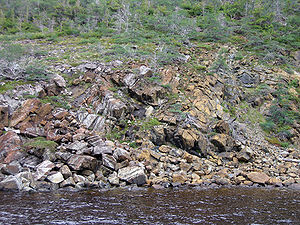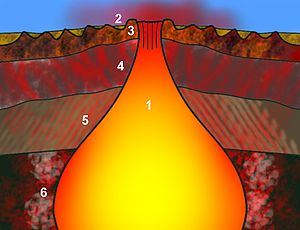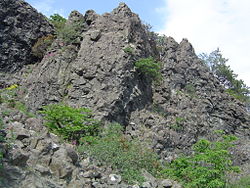- Ophiolite
-
An ophiolite (
 /ˈɒfiəlaɪt/) is a section of the Earth's oceanic crust and the underlying upper mantle that has been uplifted and exposed above sea level and often emplaced onto continental crustal rocks. Ophio- is Greek for "snake" (ὄφις), -lite means "stone" from the Greek lithos (λίθος), after the often green-colored rocks (spilites and serpentinites) that make up many ophiolites.
/ˈɒfiəlaɪt/) is a section of the Earth's oceanic crust and the underlying upper mantle that has been uplifted and exposed above sea level and often emplaced onto continental crustal rocks. Ophio- is Greek for "snake" (ὄφις), -lite means "stone" from the Greek lithos (λίθος), after the often green-colored rocks (spilites and serpentinites) that make up many ophiolites.The term ophiolite was originally used by Alexandre Brongniart [1] for an assemblage of green rocks (serpentine, diabase) in the Alps; Steinmann [2] later modified its use to include serpentine, pillow lava, and chert ("Steinmann's trinity"), again based on occurrences in the Alps. The term was little used in other areas until the late 1950s to early 1960s, with the recognition that this assemblage provided an analog for oceanic crust and the process of seafloor spreading. This recognition was tied to two events: (1) the observation of magnetic anomaly stripes on the seafloor, parallel to oceanic ridge systems, interpreted by Frederick Vine and Drummond Matthews [3] to represent the formation of new crust at the oceanic ridge and its subsequent symmetric spreading away from that ridge, and (2) the observation of a sheeted dike complex within the Troodos ophiolite (Cyprus) by Ian Graham Gass and co-workers,[4] which must have formed by repetitive extension of crust and intrusion of magma resulting in a formation consisting of 100% dikes with no older wall rocks preserved within the complex. Moores and Vine[5] concluded that the sheeted dike complex at Troodos could only form by a process similar to the seafloor spreading proposed by Vine and Matthews.[3] Thus, it became widely accepted that ophiolites represent oceanic crust that had been emplaced on land.
Their great significance relates to their occurrence within mountain belts such as the Alps or the Himalayas, where they document the existence of former ocean basins that have now been consumed by subduction. This insight was one of the founding pillars of plate tectonics, and ophiolites have always played a central role in plate tectonic theory and the interpretation of ancient mountain belts.
Contents
Stratigraphy and definition
The stratigraphic sequence observed in ophiolites corresponds to the lithosphere-forming processes at mid-oceanic ridges:
- Sediments: muds (black shale) and cherts deposited since the crust formed.
- Extrusive sequence: basaltic pillow lavas show magma/seawater contact.
- Sheeted dikes: vertical, parallel dikes which fed lavas above.
- High level intrusives: isotropic gabbro, indicative of fractionated magma chamber.
- Layered gabbro, resulting from settling out of minerals from a magma chamber.
- Cumulate peridotite: dunite-rich layers of minerals that settled out from a magma chamber.
- Tectonized peridotite: harzburgite/lherzolite-rich mantle rock.
An international conference on ophiolites in 1972 redefined the term ophiolite to include only the igneous rocks listed above, excluding the sediments formed independently of the crust they sit on.[citation needed] This definition has been challenged recently because new studies of oceanic crust by the Integrated Ocean Drilling Program and other research cruises have shown that in situ ocean crust can be quite variable, and that in places volcanic rocks sit directly on peridotite tectonite, with no intervening gabbros.
Research
Scientists have only drilled about 1.5 km into the 6–7 km thick oceanic crust, so their understanding of oceanic crust largely comes from comparing ophiolite structure to seismic soundings of in situ oceanic crust. Oceanic crust has a layered velocity structure that implies a layered rock series similar that listed above. In detail there are problems, with many ophiolites exhibiting thinner accumulations of igneous rock than are inferred for oceanic crust. Another problem relating oceanic crust and ophiolites is that the thick gabbro layer of ophiolites calls for large magma chambers beneath mid-ocean ridges. Seismic sounding of mid-ocean ridges has only revealed a few magma chambers beneath ridges, and these are quite thin. A few deep drill holes into oceanic crust have intercepted gabbro, but it is not layered like ophiolite gabbro.[citation needed]
The circulation of hydrothermal fluid through young oceanic crust causes serpentinization, alteration of the peridotites and alteration of minerals in the gabbros and basalts to lower temperature assemblages. For example, plagioclase, pyroxenes, and olivine in the sheeted dikes and lavas will alter to Albite, chlorite and serpentine, respectively. Often, ore bodies such as iron-rich sulfide deposits are found above highly altered epidosites (epidote-quartz rocks) that are evidence of (the now relict) black smokers which continue to operate within the seafloor spreading centers of ocean ridges today.[citation needed]
Thus there is reason to believe that ophiolites are indeed oceanic mantle and crust; however, certain problems arise when looking closer. Compositional differences regarding silica (SiO2) and titania (TiO2) contents, for example, place ophiolite basalts in the domain of subduction zones (~55% silica, <1% TiO2), whereas mid-ocean ridge basalts typically have ~50% silica and 1.5-2.5% TiO2. These chemical differences extend to a range of trace elements as well (that is, chemical elements occurring amounts of 1000 ppm or less). In particular, trace elements associated with subduction zone (island arc) volcanics tend to be high in ophiolites, whereas trace elements that are high in ocean ridge basalts but low in subduction zone volcanics are also low in ophiolites [6].
The crystallization order of feldspar and pyroxene in the gabbros is unexpectedly reversed, and ophiolites also appear to have a multi-phase magmatic complexity on par with subduction zones. Indeed, there is increasing evidence that most ophiolites are generated when subduction begins and thus represent fragments of fore-arc lithosphere. This led to introduction of the term "supra-subduction zone" (SSZ) ophiolite in the 1980s to acknowledge that some ophiolites are more closely related to island arcs than ocean ridges. Ironically, some of the classic ophiolite occurrences used to relate ophiolites to seafloor spreading (Troodos in Cyprus, Semail in Oman) were found to be "SSZ" ophiolites, formed by rapid extension of fore-arc crust during subduction initiation [7].
A fore-arc setting for most ophiolites also solves the otherwise perplexing problem of how oceanic lithosphere can be emplaced on top of continental crust. It appears that continental crust, if carried by the downgoing plate into a subduction zone, will jam it up and cause subduction to cease, resulting in the rebound of the continental crust with forearc lithosphere (ophiolite) on top of it. Ophiolites with compositions comparable with hotspot-type eruptive settings or normal mid-oceanic ridge basalt are rare, and those examples are generally strongly dismembered in subduction zone accretionary complexes.[citation needed]
Ophiolite groups and assemblages
 Classic ophiolite assemblage in Cyprus showing sheeted lava intersected by a dyke with pillow lava on top.
Classic ophiolite assemblage in Cyprus showing sheeted lava intersected by a dyke with pillow lava on top.
Most ophiolites can be divided into one of two groups: Tethyan and Cordilleran. Tethyan ophiolites are characteristic of those that occur in the eastern Mediterranean sea area, e.g., Troodos in Cyprus and in the Middle East such as Semail in Oman, which consist of relatively complete rock series corresponding to the classic ophiolite assemblage and which have been emplaced onto a passive continental margin more or less intact (Tethys is the name given to the ancient sea that once separated Europe and Africa). Cordilleran ophiolites are characteristic of those that occur in the mountain belts of western North America (the "Cordillera" or backbone of the continent). These ophiolites sit on subduction zone accretionary complexes (subduction complexes) and have no association with a passive continental margin. These include the Coast Range ophiolite of California, the Josephine ophiolite of the Klamath Mountains (California, Oregon), and ophiolites in the southern Andes of South America. Despite their differences in mode of emplacement, both types of ophiolite are exclusively SSZ in origin. [8]
Ophiolite assemblages in the Alps and some other collisional mountain belts are not formed during subduction, but rather represent the thinned margin of the continent that forms during rifting and continental drift. This incipient ocean crust remains locked to the continental margin when the ocean basin closes, emplacing the incipient ocean crust into the collision zone.[citation needed]
Interestingly, the age of ophiolite formation is often surprisingly close to the age of their emplacement into the continental crust. Ophiolites are found in all the major mountain belts of the world whether collisional (e.g. Himalayas) or not (e.g. Andes). The subduction-related chemistry of ophiolites and their association with mountain belts suggests that their formation and emplacement are related to oceanic closure and continental collision (final stages of the Wilson Cycle) rather than oceanic opening and seafloor spreading as was first thought.[citation needed]
Furthermore, the occurrence of ophiolites throughout Earth history is not constant but rather they were formed and emplaced at specific intervals. These intervals correspond closely to times of super-continent break-up and dispersal—not because they form at the ridges that separate the drifting continents, but because the large ocean basin that must coexist with any super-continent must subduct along new subduction zones as rifting progresses.[citation needed]
Notable ophiolites
See also: list of ophiolitesExamples of ophiolites that have been influential in the study of these rocks bodies are:
- Semail Ophiolite in Oman and the United Arab Emirates, widely considered one of the best exposed ophiolite sequences
- Troodos Ophiolite in the Troodos Mountains of Cyprus, in these case its study has partly been economically motivated as the copper deposits of Cyprus are part of the ophiolite.
- Bay of Islands Ophiolite in Gros Morne National Park, Newfoundland, named a UNESCO World Heritage Site in 1987 because of its superbly exposed complete ophiolite stratigraphic sequence
- Yakuno, Horokanai, and Poroshiri, three full ophiolite sequences in Japan
- Dun Mountain Ophiolite Belt, South Island, New Zealand. The rocktype dunite is named after this locality.
Notes
References
- Brogniart, A. (1813) Essai de classifacation mineralogique des roches melanges, Journal des Mines, v. XXXIV, 190-199
- Church, W. R. and R. K. Stevens (1970) Early Paleozoic ophiolite complexes of the Newfoundland Appalachians as mantle-oceanic crust sequences, Journal of Geophysical Research, 76, 1460-1466
- Coleman, R. G. (1977) Ophiolites: Ancient Oceanic Lithosphere? Springer Verlag, 229 pp
- Encarnacion, J. (2004) Multiple ophiolite generation preserved in the northern Philippines and the growth of an island arc complex, Tectonophysics, 392, 103-130
- Gass, I. G. (1968) Is the Troodos massif of Cyprus a fragment of Mesozoic ocean floor? Nature, 220, 39-42
- Metcalf, R. V., and J. W. Shervais, (2008) Supra-Subduction Zone (SSZ) Ophiolites: Is There Really An "Ophiolite Conundrum"?, in James E. Wright and John W. Shervais, editors, Ophiolites, Arcs, and Batholiths: A Tribute to Cliff Hopson, Geological Society of America Special Paper 438, p. 191–222, doi: 10.1130/2008.2438(07)
- Moores E. M. and F. J. Vine (1971) The Troodos massif, Cyprus, and other ophiolites as oceanic crust: Evaluation and implications, Philosophical Transactions of the Royal Society of London, 268A, 443-466
- Moores, E. M. (2003) A personal history of the ophiolite concept, in Dilek and Newcomb, editors, Ophiolite Concept and the Evolution of Geologic Thought, Geological Society of America Special Publication 373, 17-29
- Shervais, J. W., (2001) Birth, Death, and Resurrection: The Life Cycle of Suprasubduction Zone Ophiolites, Geochemistry, Geophysics, Geosystems, v. 2, Paper number 2000GC000080
- Steinmann, G. (1927) Die ophiolitshen zonen in den mediterranen Kettengebirgen, translanted and reprinted by Bernoulli and Friedman, in Dilek and Newcomb, editors, Ophiolite Concept and the Evolution of Geologic Thought, Geological Society of America Special Publication 373, 77-91
- Vine, F. J. and D. H. Matthews (1963) Magnetic anomalies over ocean ridges, Nature, 199, 947-949
External links
Categories:- Plate tectonics
- Igneous rocks
- Oceanography
Wikimedia Foundation. 2010.



